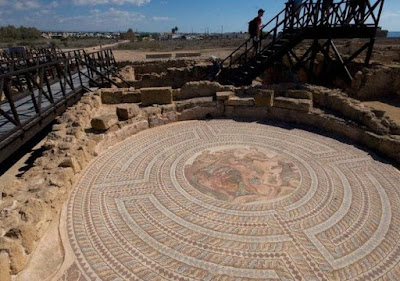Filenews 16 July 2021 - by Dora Christodoulou
After decades of inactivity and planning that have not been transformed for various reasons into operations, the construction and installation of a special shelter for the protection of the mosaics of Kato Paphos is now a step from the beginning of the implementation processes. The Department of Antiquities has essentially completed the preparation required for this important and specialized project, through the process of evaluating the proposals submitted by architectural offices, within the framework of the international competition launched for the creation of shelters for mosaics and other important monuments of the archaeological site of Nea Paphos.
Following this development, a list of six successful candidates has been prepared, who are expected to submit a proposal for a study on the roof, in order to select the office that will eventually undertake the project. Along the way, the final study will be evaluated in order to examine the functionality of the whole design, based on the criteria and needs of the archaeological site, the competent state department clarifies in a statement.
The study on the creation of shelters is part of the actions promoted through the collaboration of the Department of Antiquities with the Getty Conservation Institute of Los Angeles, U.S., which was launched in 2018 to create a Conservation and Management Plan for the archaeological sites of New Paphos and Tombs of the Kings. This cooperation is the result of the strategy of the Department of Antiquities for the implementation of the latest international achievements in the field of cultural heritage management, in the archaeological sites, monuments and museums of our country.
The process for the study of shelters had begun in April 2019 with the invitation and on-site meeting of a team of scientists from abroad specializing in various fields, such as architecture, engineering, environmental engineering and hydrology, and with extensive experience in the design of shelters in other UNESCO World Heritage sites.
The central axis for the design and implementation of the shelters are the specific conditions and characteristics that govern an archaeological site, such as the need to protect sensitive archaeological residues, the preservation of the authenticity and integrity of the site as a whole, but also in relation to the natural environment, the integrated interpretation, presentation and development of the visitor experience.
"Further, the detailed and careful evaluation of all these elements, with the contribution of the most recognized specialist scientists internationally, testifies," say officials of the Department, "the great importance that the Department of Antiquities places in finding the best possible solution for the unique mosaics of this most important archaeological site that is also part of the UNESCO World Heritage Site.
Understandably, the whole process, from the assessment of archaeological residues, risks and needs, to the selection of the architectural office with international competition and the design, requires a specific timetable for all individual actions".
Although the time frame was affected by the negative effects of the coronavirus pandemic on the field of work worldwide, however, the process is ongoing, according to the programming of the Department of Antiquities and the Getty Conservation Institute.
Finally, it should be stressed that until the completion and implementation of this study, the mosaics of the archaeological site are in no way left without protection.

